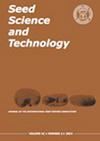Early counts of radicle emergence, counted manually and by image analysis, can reveal differences in the production of normal seedlings and the vigour of seed lots of cauliflower
IF 3
4区 农林科学
Q2 AGRONOMY
引用次数: 5
Abstract
The ability of a single early count of radicle emergence (RE) to predict differences in the production of normal seedlings (NG) and seed vigour was examined in four seed lots from each of three varieties of cauliflower (Brassica oleracea var botrytis). Initial seed quality was assessed in germination and controlled deterioration (CD) vigour tests. RE (first appearance of the radicle) was counted manually after 48 hours in the germination test (RE 48h 20/30°C) and every two hours for 144 hours at 20°C using automated image analysis. Seed vigour was assessed in field and glasshouse trials. A large proportion of the variance in NG was explained by the RE count. The same RE counts at 20/30°C and 20°C predicted seed vigour in the field and glasshouse and revealed the same vigour differences as the validated CD test. Differences in vigour (field and glasshouse emergence) observed between varieties were related to the extent of previously sustained seed ageing revealed by the CD test, although genotypic differences in vigour could not be excluded. We propose that single counts of RE taken manually or by image analysis can be used to reveal differences in the NG and vigour of seed lots of cauliflower.通过人工和图像分析对花椰菜胚根萌发的早期计数,可以揭示正常幼苗的生产和种子活力的差异
采用3个菜花品种(Brassica oleracea var botrytis)的4个种子批次,研究了单次早期胚根出苗计数(RE)预测正常幼苗(NG)产量和种子活力差异的能力。通过萌发和控制变质(CD)活力试验评价种子的初始质量。在萌发试验(RE 48h 20/30°C)中,48小时后人工计数胚根初现率(RE),在20°C条件下,每2小时计数一次,共144小时,使用自动图像分析。通过田间和温室试验对种子活力进行了评价。NG的很大一部分方差可以用RE计数来解释。在20/30°C和20°C条件下,相同的RE计数预测田间和温室种子活力,并显示出与CD试验相同的活力差异。不同品种间活力(田间和温室出苗)的差异与CD试验揭示的先前持续的种子老化程度有关,尽管活力的基因型差异不能排除。我们提出,人工或图像分析的单次RE计数可以用来揭示菜花种子群的NG和活力的差异。
本文章由计算机程序翻译,如有差异,请以英文原文为准。
求助全文
约1分钟内获得全文
求助全文
来源期刊

Seed Science and Technology
农林科学-农艺学
CiteScore
3.00
自引率
28.60%
发文量
36
审稿时长
>36 weeks
期刊介绍:
Seed Science and Technology (SST) is an international journal featuring original papers and articles on seed quality and physiology related to seed production, harvest, processing, sampling, storage, genetic conservation, habitat regeneration, distribution and testing. A journal that meets the needs of researchers, advisers and all those involved in the improvement and technical control of seed quality. Published every April, August and December.
 求助内容:
求助内容: 应助结果提醒方式:
应助结果提醒方式:


